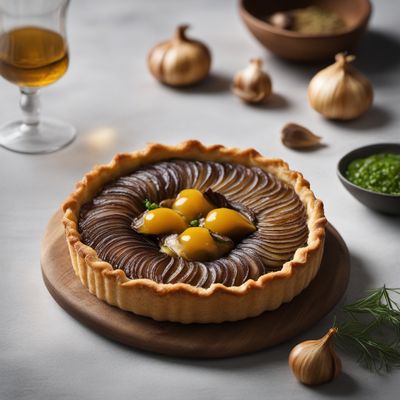
Dish
Weimarer Zwiebelkuchen
Weimarer Zwiebelkuchen is made with a yeast dough that is topped with a mixture of sautéed onions, bacon, and cream. The pie is then baked until the crust is golden brown and the filling is set. The dish is typically served warm and can be enjoyed on its own or with a side salad.
Origins and history
Weimarer Zwiebelkuchen has been a popular dish in Germany for centuries. It is believed to have originated in the city of Weimar in the 16th century. The dish was traditionally served during the onion harvest season in the fall. Today, it is enjoyed throughout Germany and is a staple of traditional German cuisine.
Dietary considerations
This dish is not suitable for vegetarians or vegans due to the use of bacon and cream. It is also not gluten-free due to the use of wheat flour in the dough.
Variations
There are many variations of Weimarer Zwiebelkuchen, some of which include the addition of cheese or herbs to the filling. Some recipes also call for the use of a shortcrust pastry instead of a yeast dough.
Presentation and garnishing
Weimarer Zwiebelkuchen can be presented as a whole pie or as individual slices. It is typically garnished with fresh herbs or a sprinkle of paprika.
Tips & Tricks
To make the perfect Weimarer Zwiebelkuchen, be sure to sauté the onions until they are caramelized and sweet. This will give the filling a rich, deep flavor. Also, be sure to let the pie cool for a few minutes before slicing to allow the filling to set.
Side-dishes
Weimarer Zwiebelkuchen can be served with a side salad or roasted vegetables. It is also delicious with a glass of German Riesling or a light beer.
Drink pairings
German Riesling or a light beer
Delicious Weimarer Zwiebelkuchen recipes
More dishes from this category... Browse all »

Adjarian khachapuri
Georgian cuisine

Alevropita
Greek cuisine

Bacon and Egg Pie
British cuisine

Beef and Guinness Pie
Irish cuisine

Belokranjska povitica
Slovenian cuisine

Benkovački prisnac
Croatian cuisine

Bureek tajin
Algerian cuisine

Bölletünne
German cuisine
More cuisines from this region... Browse all »

Baden cuisine
Savory, Hearty, Tangy, Smoky, Sweet

Bavarian cuisine
Savory, Hearty, Tangy, Sour, Sweet

Brandenburg cuisine
Savory, Earthy, Hearty

Franconian cuisine
Hearty, Savory, Flavorful

Hamburg cuisine
Light, Flavorful, Fresh

Hessian cuisine
Hearty, Savory, Flavorful

Lower Saxon cuisine
Savory, Hearty, Salty, Sour, Sweet

Mecklenburg cuisine
Fresh, Simple, Rustic, Savory

